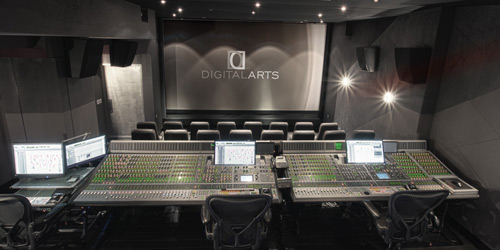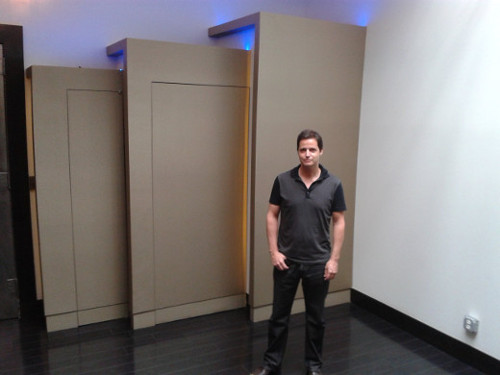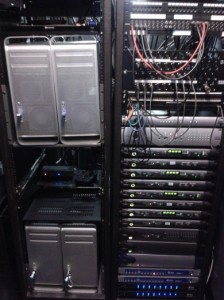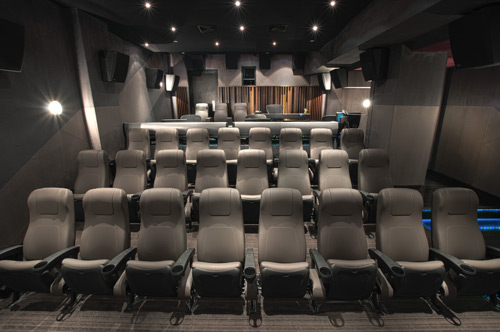Another Elevation for NYC Audio Post: Digital Arts Launches 4K Theater
It’s a magic time in New York City’s audio post scene: Major new sound stages equipped to mix Hollywood sound seem to be appearing out of nowhere.
The latest facility that’s taking audio – as well as video – pros by surprise isn’t new to NYC: Digital Arts, which occupies 12,000 sq. ft. on West 29th Street, has been in operation for 21 years. But their latest upgrade is sure to put a stop to the under-the-radar status that this prolific post resource has enjoyed up until now.
At the center of attention is Digital Arts’ groundbreaking Ultra High Definition theater that stands as the East Coast’s first true-4K post production facility. But as good as everything looks in this 27-seat theater, the sound may be even more impressive, providing a Dolby-approved re-recording dubstage for 7.1 and 5.1 surround/stereo audio mixing that’s already attracting top projects, from Woody Allen films to HBO and beyond.

The new Digital Arts 4k theater is NYC’s latest facility to meet Hollywood audio post mixing standards.
European Origins
Ride the elevator up to the penthouse of the Flower District building that Digital Arts occupies, step out of the box, and visitors find themselves in a striking lobby. There a skylight illuminates a hybrid Bauhaus/minimalist design and high ceilings just outside the entrance to the 4K theater and mix stage.
The creator of the ultra-modern environment is Axel Ericson, a native of Switzerland who launched his audio career working at Parisian radio networks in the 1980’s. Ericson moved to the US, and began to build up his credits as a sound designer, engineer and producer with an advanced understanding of digital workflows.
Determined to work at a faster, digital-enabled pace than most of the major NYC studios were capable of at the time, Ericson launched Digital Arts in 1992. Music video production was another one of his shop’s specialties, laying the foundation for a highly diversified facility that has quietly been in a constant state of expansion ever since.
Today, Digital Arts offers a full range of production and post-production services for digital cinema, television, and other media industries. All told, it operates two shooting stages, provides 4K and 2K Digital Intermediate color grading and finishing, as well as DCP (Digital Cinema Package) mastering, to its clients, as well as a number of audio post suites for television. Additional audio services include editorial, sound design, ADR and voiceover recording.
All of this for a client list that includes independent and major studio films, plus A&E, Disney Channel, National Geographic, IFC, Rockstar Games, Travel Channel, PBS, ABC, NBC & VH1.
Ericson built up his new 4K theater with a no-compromise philosophy in sync with the current filmmaking environment. “As the film industry becomes more efficient, budgets are coming down,” he observes. “But that doesn’t mean that the product has to suffer – it just means that things can take less time. We’re a next-generation facility, but I also want to bring back that feeling of the great facilities of the past, and reflect that vibe of NYC by creating this environment that’s inspiring: You work in here, and the quality of the studio itself can push you to do great work.”

Axel Ericson in the Digital Arts theater lobby — the skylit space is designed to create balance with the cinematic environment inside.
Built for Film
Stepping out of the sun-filled Eurolobby and into the theater, visitors encounter an extremely sophisticated mix environment.
Ericson specified an extremely crisp, accurate, and powerful Meyer Sound 7.1 monitoring system for the theater, consisting of three Acheron Studio screen channel loudspeakers, three X-800C cinema subwoofers, and 12 HMS-10 cinema surround loudspeakers. Meyer’s Galileo loudspeaker management system with two Galileo 408 processors provides system optimization within the room. Sound mixing teams can control the action via dual 32 channel Avid ICON D-Control ES consoles, linked to four satellite Avid Pro Tools HDX2 systems, and 512 channels of SSL XLogic Alpha-Link MADI I/O.
Meanwhile, even the most audio-centric mixer will be captivated by the quality of what they see in front of them, courtesy of a Christie 4220 4K digital projector with a 17ft 4K mesh screen, from Image Screens in Germany. When 4K-native footage – a format that adds up to twice the horizontal and vertical resolution of today’s 1080p HDTV standard — is played out, the visual experience here is positively breathtaking, displaying reach-out-and-touch-it imagery that represents the obvious next level in cinema and home entertainment.
“It wasn’t just that we were building a new room — we wanted to take a fresh look at everything when we designed this theater,” Ericson says. “We questioned everything, from the screen the speakers to the square footage. I went through a huge level of minutiae, not accepting things just because they had been done before – every detail specified here probably got my attention. The same goes for all the fabric, all the materials, how dense the insulations should be – the default recommendations were for two inches thick, I settled for four, as it was a better choice.
“In NYC, the real estate will always be a battle, and the rooms are never as big as you’d like them to be,” Ericson continues. “So the question is, ‘How well is your room going to translate to bigger environment? Is it accurate?’ We made sure that we gave the mixer the tools so they could capture all of the details of the original footage, to get the best out of his mix. And because this room is also a video grading environment, the people walking in here are blown away by the picture. We probably have the best picture in NYC. This room is here to show people that we take the needs of the film world seriously.”
On Time Arrival
In the short time that Digital Arts’ 4K theater has been online, the film world seems to be responding in kind. The room has already served as the audio facilities for the iconic sound mixer Lee Dichter to complete Woody Allen’s new feature Blue Jasmine, the HBO music documentary Beyoncé: Life Is But A Dream, and completed the audio design and mixing on director Daniel Patrick Carbone’s feature Hide Your Smiling Faces. In addition, Digital Arts also conducted the DI color grade on the feature Plus One, attended by director by Dennis Iliadis and cinematographer Mihai Malaimare Jr.
The completion of the buildout was especially fortuitous for Digital Arts, coming as it does just months after the closing of Sound One, which for decades stood as the undisputed flagship for film and TV mixing in NYC. Like the recently opened Harbor Sound, which added 10,000 sq. ft. of Dolby-certified space in TriBeCa, Digital Arts’ 4K theater now stands as an essential component in the rebuilding of NYC’s major-league post offerings.
“Sound One was a legendary space,” Ericson says. “So much great work had been done there for a long time, and for them to go down is a huge loss. It’s hard to recreate those large infrastructures and NYC real estate being what it is doesn’t help right now.
“That creates a new challenge. Who’s going to rise up to it? We’ve talked to a lot of people who were there, like Lee Dichter, and they’re starting to work here. Plus, the post incentives have kicked in, which is bringing in a lot of business from out of town. The good news is that people are moving on, and now is a new chapter in NYC’s history.”
Digital Arts should also continue to benefit from its varied business model, where it strives to be a leader in both audio and video post. “We like being more multifaceted, because it changes who we’re talking to and connected with, and when we’re brought into the project,” explains Ericson. “There’s a great deal of efficiency that comes with having everything, image and sound, under one roof. The combination creates a language, whether you’re composing to image, or creating image to sound. I’ve always loved the juxtaposition of the two.

The theater’s machine room: It requires a fraction of the space formerly required for a facility of its capabilities.
“But the broader story of my career is that I’m always following the digital transition, where major tectonic plates are crossing. When people were arguing over whether analog tape sounded better than digital, the focus of that conversation for me was what is possible, and what new language we could create.
“Now 4K is offering a superior experience in film, and as Moore’s law continues on, you’ve got a whole new language once again. I’m fascinated with what great possibilities can be achieved as we follow that path.”
Bigger Post Possibilities
As Ericson pointed out earlier, the overall budgets for productions – for independent films and Hollywood releases alike — are trending downward. Still, the box office take for movie studios so far in 2013 is already $6 billion-plus, making it a large-grossing sector to be a part of. And he also sees aspects of the changing landscape that mean not only more content being made, but potentially more work associated with individual film productions.
“Where do you start?” Ericson asks, when asked how he sees the media environment evolving. “This will be an ongoing process. The main thing we have to look at is that no part of the pipeline is analog anymore. The entire technology supporting the infrastructure, including distribution, is based on computers.
“On the film front, there have been many challenges to traditional methodologies. The ability to make changes on a work in progress are there now, and we’re seeing a huge amount of that – where movies are being mixed or finished, re-edited and rechanged all the time. The Hollywood studios are now used to running test audiences, so they keep changing until they think they’ve got it. So for the team, including the sound team, that means constantly re-editing.
“Picture is never ‘locked’ anymore. There are huge advantages to that, but it’s got to be used wisely. Just because you can doesn’t mean you should, and there can be a feeling of too many cooks in the kitchen. Nothing will replace a great vision and a great director.”
Better Before Bigger
For an adventurous company like Digital Arts, one of the prime payoffs of a big investment like their 4K theater is not just more business, but more people to explore and create with.
“This is a huge resource for filmmakers,” Axel Ericson says. “As the word is starting to spread, people are intrigued: ‘How did this large facility appear out of nowhere?’ There’s a sense of excitement about it.
“Although it’s exhilarating for me to reach outside of our network, my goal is not to be the biggest, but to keep our eyes on quality and focus on our clientele. As a result they’ve been keeping me busy. That’s how it’s supposed to work.”
— David Weiss
Please note: When you buy products through links on this page, we may earn an affiliate commission.







